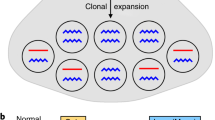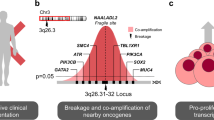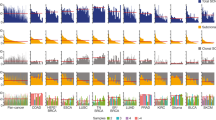Abstract
To define regions of deletion of chromosome 6q in breast cancer, we scored 18 (CA)n microsatellites for allelic imbalance (AI) in 42 paired blood/tumour samples. Heterozygosity frequencies of the markers in the sample population ranged from 31% to 92% (mean 68%). Two regions of the chromosome arm showed AI values greater than the background range of 10-22% (mean 17%) of informative cases that was observed with five markers spanning 6q21-q25.2. Firstly, seven markers gave AI values that averaged 35% in a region flanked by D6S313 (AI = 10%) at 6q13 and D6S283 (AI = 17%) at 6q16.3-21. The second region showed marginally increased AI at 6q25.2-q27 and included D6S193, previously shown to be close to a tumour-suppressor gene involved in ovarian carcinoma. Since AI of 6q in breast cancer was shown previously to be due predominantly to loss of heterozygosity, our results suggest the presence of at least two tumour-suppressor genes on 6q that are involved in breast cancer. The proximal region has not been recognised in breast cancer before and is involved in a higher frequency of tumours than the distal region.
This is a preview of subscription content, access via your institution
Access options
Subscribe to this journal
Receive 24 print issues and online access
$259.00 per year
only $10.79 per issue
Buy this article
- Purchase on Springer Link
- Instant access to full article PDF
Prices may be subject to local taxes which are calculated during checkout
Similar content being viewed by others
Author information
Authors and Affiliations
Rights and permissions
About this article
Cite this article
Orphanos, V., McGown, G., Hey, Y. et al. Proximal 6q, a region showing allele loss in primary breast cancer. Br J Cancer 71, 290–293 (1995). https://doi.org/10.1038/bjc.1995.58
Issue Date:
DOI: https://doi.org/10.1038/bjc.1995.58
This article is cited by
-
6q deletion is frequent but unrelated to patient prognosis in breast cancer
Breast Cancer (2022)
-
Parkin and mitophagy in cancer
Oncogene (2017)
-
Correlated break at PARK2/FRA6E and loss of AF-6/Afadin protein expression are associated with poor outcome in breast cancer
Oncogene (2007)
-
Alternative splicing of the imprinted candidate tumor suppressor gene ZAC regulates its antiproliferative and DNA binding activities
Oncogene (2001)
-
PA26, a novel target of the p53 tumor suppressor and member of the GADD family of DNA damage and growth arrest inducible genes
Oncogene (1999)



